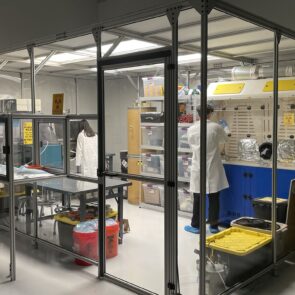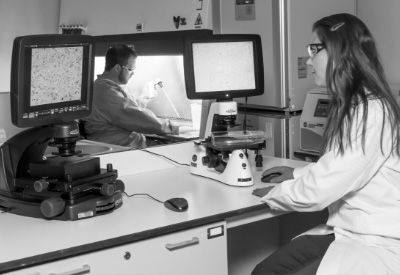City Labs has emerged at the forefront of energy innovation thanks to our revolutionary NanoTritium™ batteries. Central to the functionality of these cutting-edge power sources are beta particles—a fundamental component of tritium decay.
In this article, we explore the unique properties of beta particles that allow them to be harnessed as a novel energy solution.
Beta Particles Explained

This process unleashes low-energy positrons in the form of beta particles, setting in motion the conversion of radioactive decay into usable electrical energy—a principle fundamental to the operation of NanoTritium™ batteries.
The Role of Tritium in Power Generation
With its unique composition of two neutrons and one proton in its nucleus, tritium stands as the fundamental element powering NanoTritium™ batteries. As a radioactive isotope of hydrogen, tritium boasts the remarkable capability to emit beta radiation consistently, rendering it an exceptionally reliable source for sustainable energy generation. This inherent property makes tritium an ideal candidate for the development of long-lasting power solutions.
Central to tritium’s energy-generating prowess is its beta particle emission, a phenomenon caused by its instability. These beta particles play a pivotal role in initiating the betavoltaic conversion process—a mechanism leveraged by City Labs to harness the continuous production of electrical power from tritium decay.
By tapping into tritium’s innate radioactive properties, City Labs has unlocked a robust and enduring energy source that underpins the functionality of NanoTritium™ batteries, enabling them to provide uninterrupted power for a variety of applications, from remote sensing to medical implants.
Containing Beta Particles: Safety and Precautions
While it’s true that emitted beta particles have relatively low energy and are incapable of penetrating human skin, it’s essential to implement comprehensive safety protocols to mitigate any potential health risks associated with tritium exposure. Exposure to tritium through ingestion, inhalation, or prolonged external contact can still pose significant hazards to human health.
Therefore, it’s imperative to adopt rigorous safety measures to safeguard against any unintended exposure. Radiation protection measures, such as the application of minimal coatings or encapsulation, play a critical role in blocking tritium’s radiation and ensuring the safe handling and utilization of NanoTritium™ batteries. These protective layers act as effective barriers, preventing the escape of beta particles and minimizing the risk of radiation exposure to individuals and the environment.
Additionally, adherence to stringent safety guidelines and regulations, coupled with ongoing monitoring and training programs, further enhances the overall safety protocols associated with the use of tritium-based technologies. By prioritizing safety at every stage of development, production, and deployment, City Labs reaffirms our commitment to providing innovative, safe, and sustainable energy solutions for a wide range of applications.
Applications of Beta Particles
The versatility and potential applications of beta particles extend far beyond their role in powering NanoTritium™ batteries. While NanoTritium™ batteries represent a significant advancement, beta particles hold promise for revolutionizing various industries and technologies.
For instance, in the realm of illumination, beta-emitting isotopes have long been used to create self-luminous devices, including exit signs and watch dials, offering a reliable and maintenance-free light source. Additionally, beta particles play a crucial role in fueling specific types of nuclear reactors, contributing to the generation of clean and sustainable energy.
Beyond these traditional applications, City Labs’ innovative betavoltaic technology is spearheading the exploration of new frontiers in energy storage. By harnessing the power of beta decay, City Labs is paving the way for advancements in energy harvesting and storage, particularly in the realm of low-power microelectronics. These innovations could revolutionize a wide range of applications by providing efficient and long-lasting power solutions tailored to the demands of diverse environments.
As City Labs continues pushing the boundaries of nuclear battery technology, the possibilities for leveraging beta particles to power the future are virtually limitless, promising transformative advancements across industries and enhancing sustainability efforts worldwide.
City Labs’ NanoTritium™ Batteries: Pioneering Sustainable Energy Solutions
City Labs’ unwavering commitment to innovation and sustainability reaches its pinnacle through the groundbreaking development of NanoTritium™ batteries—an extraordinary testament to the transformative capabilities inherent in beta particles.
In stark contrast to traditional batteries reliant on electrochemical reactions, NanoTritium™ batteries represent a revolutionary leap forward by harnessing the principles of betavoltaic conversion. This innovative approach guarantees unparalleled longevity and reliability, heralding a new era of sustainable energy storage solutions.
With a lifespan exceeding double that of conventional batteries, NanoTritium™ batteries emerge as a beacon of sustainability, offering a compelling alternative for applications in extreme or remote environments where continuous power availability is paramount.
By leveraging the unique properties of beta particles and tritium’s radioactive decay—specifically beta decay—City Labs has engineered a suite of products that transcends the limitations of traditional energy storage methods.
Moreover, NanoTritium™ batteries provide extended operational lifespans and boast enhanced durability and resilience, making them ideally suited for deployment in harsh or inaccessible environments where maintenance may be challenging. Whether powering remote sensors in rugged climates, supporting critical infrastructure in isolated locations, or facilitating long-term missions in space exploration, NanoTritium™ batteries illustrate City Labs’ dedication to pushing the boundaries of sustainable energy innovation.
As the global demand for reliable and eco-friendly energy solutions continues to soar, NanoTritium™ batteries offer a glimpse into a future powered by clean, efficient, and long-lasting energy sources. With City Labs leading the charge, the transformative potential of beta particles is fully realized, propelling us toward a more resilient and sustainable energy landscape.
City Labs and the Future of Energy Innovation
As we navigate the complexities of energy technology, the significance of harnessing beta decay in driving innovation cannot be overstated. From powering NanoTritium™ batteries to fueling advancements in diverse industries, beta particles pave the way for sustainable energy solutions.
City Labs remains steadfast in our mission to harness the potential of beta particles as we partner with industry leaders in a joint effort towards a future powered by clean energy. City Labs is always open to collaborations to achieve these vast goals, and we welcome you to contact us to explore potential collaboration opportunities.










